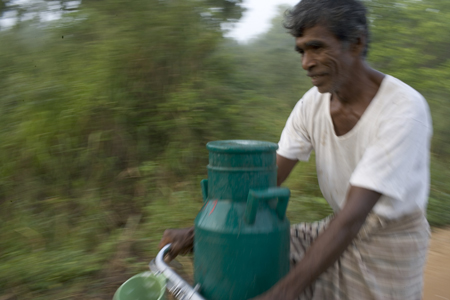SRI LANKA: Milking cattle’s potential
COLOMBO, 3 August 2012 (IRIN) – Dairy farming could boost incomes and the nutritional status of tens of thousands of returnees in Sri Lanka’s former war zone in the north of the island, where wage-paying jobs are still scarce.
 “The livestock sector has vast potential for contributing towards economic development, poverty alleviation and nutritional deficiency, and creating opportunities for involving [more] women in the economic development process,” said Patrick Charignon, Head of Livelihood Development at the International Organization for Migration (IOM) in Sri Lanka.
“The livestock sector has vast potential for contributing towards economic development, poverty alleviation and nutritional deficiency, and creating opportunities for involving [more] women in the economic development process,” said Patrick Charignon, Head of Livelihood Development at the International Organization for Migration (IOM) in Sri Lanka.
Many households have taken up cattle farming or, in some cases, returned to it. Over 51 percent of the 131,000 returnee families in the former conflict zone now manage livestock, a recent UN and government survey discovered. Others who currently do not have cattle report owning them in the past.
From 1983 to 2009 there was civil war between Sri Lankan government forces and the separatist Liberation Tigers of Tamil Eelam (LTTE), based mainly in the north and east. Northern Province used to be a milk-producing area, and more than half the population worked with livestock before farmers started fleeing the fighting in late 2008.
Livestock management was a major cottage industry in the region even during the war, said Seenithamby Manoharan, the senior rural development specialist in the World Bank’s office in Colombo, the capital. Livestock rearing has grown more popular among returnees since it is relatively easy to manage and does not involve long hours when there are few animals, as is the case with most households.
Current dairy production meets less than 15 percent of the demand in Northern Province, which IOM estimated at more than 91,000 tons of milk annually in a recent assessment, and concluded that there is untapped potential in dairy farming. Increasing dairy production by about 50 percent is “critical” to improving nutritional status in the region.
The preliminary findings of a March 2012 nutrition assessment by the government, the UN World Food Programme, and the UN Children’s Fund (UNICEF) indicated worsening acute malnutrition in children aged under five, currently estimated at 18.3 percent for the entire Northern Province and 20 percent among returnees. Anything beyond 15 percent is widely considered an emergency.
Experts at the UN Food and Agriculture Organization (FAO) said nurturing dairy farming could benefit related industries like milk processing, veterinary services and animal feed.
Barriers
Yet keeping livestock is still seen by many as something to meet a household’s needs rather than earning income. Not many young people are taking  it up, said Shakthevale Arinesarajah, an FAO livestock consultant in Sri Lanka.
it up, said Shakthevale Arinesarajah, an FAO livestock consultant in Sri Lanka.
Livestock farming cannot take off without more infrastructure. “We have a good market and good prices, but still, if we can have large [milk] collection centres with electric [chilling] storage… we can get more [money],” said a returnee who gave his name as Pathinathan, in Darmapuram village in Kilinochchi District, where he manages a herd of about 50 cows.
Another drawback is herd quality. Pathinathan says unlike in other parts of the country, he is working with animals left behind during the war, and there is little effort to introduce better breeds in the north where a cow produces at most two litres of milk daily, a fraction of what is needed to meet the region’s dairy demands, as calculated by IOM.
Proper veterinary and breeding services are scarce due to lack of funding, said FAO, whose appeal for US$3 million to replace lost livestock and build infrastructure in the region had not received any pledges by the end of July.
Farmers’ organizations could benefit from better infrastructure and collective bargaining. Currently, there is no set price for milk and most farmers sell for what the buyer offers. “Having their own [milk] chilling centres will make them [farmers] viable and competitive,” said FAO’s Arinesarajah. “Then they could bargain and supply milk to any collector who pays them [a good price].”
